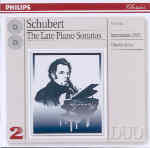Claudio Arrau came to Schubert’s sonatas in the twilight of his long recording career during the late 1970s and early 1980s. The C minor sonata bears traces of the pianist’s late-period broad tempos and italicized point-making. However, Arrau’s vocally informed phrasing and purposefully inflected bass lines substantiate these traits. A telling example of the latter can be found throughout the slow movement and in the Finale, where the motoric triplets take on a weightier urgency than the norm. Some of the pianist’s rubato gearshifts will catch listeners off-guard in the B-flat sonata’s first movement, yet the difficult-to-balance accompaniment/melody perspectives are stunningly controlled, and the development section turns increasingly intense and impassioned as it progresses. In contrast to Arrau’s inward, sustained slow movement, the Scherzo is a shade sedate, while the tempo fluctuations in the Finale soften the stabbing surprise intended by the composer’s frequent unison G-naturals.
An early digital production, the A major sonata’s more distant sonic perspective gives a truer sense of how Arrau’s bronze-cast sonority and imposing dynamic range projected in a hall. The opening movement is superbly judged in that Arrau knows just when to push the music ahead and how long to linger over local details. You might wish Arrau to declaim the slow movement’s main theme at a steadier tempo, but he positively hurls mind, fingers, and soul into the central episode’s recitative-like desolation, leaving you limp at the conclusion. The remaining movements don’t elicit equally inspired playing from Arrau, and neither do the D. 899 Impromptus, which seem overly subdued, studio-bound, and a trifle square compared to Maria João Pires’ spontaneity or Radu Lupu’s shimmering transparency. Arrau may not be your first choice for Schubert, but his artistry is never routine.
































